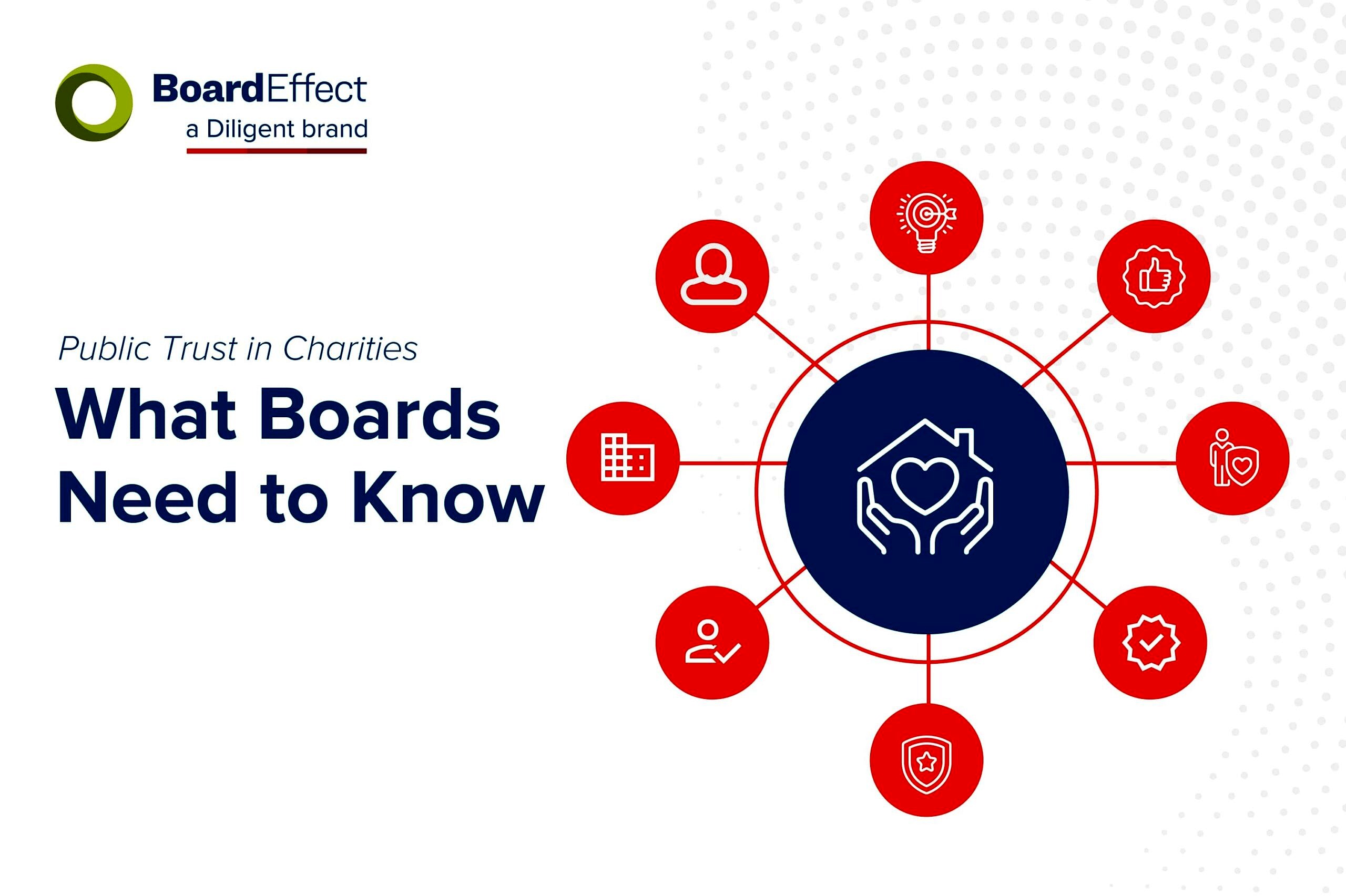
Public trust in charities: What boards need to know
Charities and nonprofit organisations play a pivotal role in addressing a multitude of societal challenges, from championing environmental conservation and healthcare accessibility to advocating for human rights and education equality. However, as we find ourselves in an age of skepticism and information overload, the question of public trust in nonprofits has taken on a new level of complexity.
For our latest infographic, we researched public trust in charities. Explore the current state of public trust in charities and examine what those numbers mean for the future of mission-driven organisations.

Download our infographic in shareable formats here: PDF, JPEG and PPT.
What drives trust in nonprofits
In her book “The Psychology of Trust,” Martha Peaslee Levine presents five key mechanisms associated with the public’s trust in nonprofit organisations:
- Promise of Mission and Values
- Organisational Reputation
- Transparency and Accountability
- Performance and Social impact
- Use of Contributions.
Levine proposes that two recent trends — nonprofit branding and accountability — have the power to enhance these mechanisms to successfully improve public trust. Nonprofit managers may be able to sustainably improve trust among the general public by focusing on the organization’s branding and accountability strategies.
The state of public trust in charities
New research delivers some interesting statistics on public trust in charitable organisations. The Charity Commission for England and Wales “Public trust in charities 2023” Report shows that over half (54%) of people in the UK say they trust charities.
Meanwhile, research by the Irish Charities Regulator reveals that 80% of Irish donors think having trust and confidence in a charity is key before deciding to donate.
Quote: “Only when organisations are trusted for their good behavior and respected for their lasting impact will they receive the support they need to carry out the work they were created to do. They earn trust through ethical behavior and gain respect by achieving real results, then communicating those qualities to be accountable.” – Ken Phillips, Civil Society Strategist, Consultant, Mentor and Author
Outcomes from lack of public trust
Lack of public trust and transparency can pose significant risks for charities and nonprofits, jeopardsing their reputation, donor relationships, and overall effectiveness. Here’s an outline of the risks associated with a reduction in trust:
- Decreased donor confidence: Without public trust, donors may become hesitant to contribute funds to the organisation. Donors want assurance that their donations will be used responsibly and effectively.
- Reduced funding: A lack of trust can lead to decreased funding opportunities from individual donors, foundations, corporations, and government agencies. This can hamper the organisation’s financial stability and ability to carry out its mission.
- Negative public perception: Nonprofits rely on their reputation to attract support. If public trust erodes, negative perceptions can spread, damaging the organisation’s image and credibility within the community.
- Diminished board trustee and volunteer engagement: Volunteers often dedicate their time to organisations they believe in. If trust is lacking, volunteers may become disengaged or reluctant to contribute their time and skills.
- Difficulties in partnering: Collaborations with other nonprofits, government agencies, and businesses are essential for expanding impact. Lack of trust can hinder partnerships and collaborative efforts.
- Legal and regulatory scrutiny: Nonprofits facing public trust issues may attract attention from regulatory authorities or legal entities, leading to investigations or audits that consume resources and further damage the organisation’s reputation.
- Reduced advocacy ompact: Nonprofits often advocate for policy changes or societal improvements. Public trust is crucial for influencing public opinion and policymakers effectively.
- Donor skepticism: When organisations aren’t transparent about their financials and how they use funds, donors may question whether their contributions are being put to good use.
- Suspicions of mismanagement: Lack of transparency can lead to suspicions of mismanagement, financial irregularities, or unethical practices. This can have severe consequences for an organisation’s credibility.
- Difficulties in attracting talent: Skilled trustees and employees are more likely to join organisations with transparent practices. Lack of transparency may deter potential employees who are concerned about the organisation’s ethical standards.
- Inaccurate reporting and misinformation: Without transparent reporting, misinformation and inaccurate information can circulate, harming the organisation’s reputation and causing confusion.
- Stakeholder distrust: Beneficiaries, volunteers, partners, and community members may lose faith in an organisation that doesn’t communicate openly. This can lead to decreased stakeholder engagement and support.
- Missed opportunities for improvement: Transparency provides valuable feedback that can help nonprofits identify areas for improvement. Without this feedback loop, organisations may miss opportunities to enhance their operations.
- Legal and ethical issues: Lack of transparency can lead to legal challenges, regulatory violations, and breaches of ethical standards, which can damage the organisation’s standing and result in legal consequences.
Charities that lack public trust and transparency face a range of interconnected risks that can impact their financial sustainability, reputation, relationships with stakeholders, and overall ability to fulfill their missions effectively. Prioritising transparency and building public trust is essential for the long-term success and impact of charitable organisations.
4 factors of public expectations of charities impacting trust
A national survey by the Charities Commission for England and Wales showed that public expectations of charities include four key factors:
- Where the money goes
- Impact
- The ‘how’ (the way they go about making that impact)
- Collective responsibility
How charities are perceived to perform against these expectations determines how much the public trusts them.
Most people tentatively think that charities are meeting key expectations, though doubts remain. The greatest area of doubt is still around whether a high proportion of money reaches intended beneficiaries.
Benefits of using governance technology to help improve trust
Governance technology can play a significant role in helping nonprofits build and maintain public trust. Charities are often held to high standards of transparency, accountability, and ethical conduct due to their social missions and reliance on public support.
Here are some ways that governance technology can contribute:
Transparency and accountability: Governance technology can provide tools for nonprofits to maintain transparent and accountable operations. This includes systems for documenting financial transactions, project progress, and decision-making processes. By making this information accessible to stakeholders — including donors, volunteers, and the general public — nonprofits can demonstrate their commitment to openness and responsible management.
Financial management: Nonprofits often rely on donations and grants to fund their activities. Governance technology can offer financial management software that helps nonprofits track their finances, create budgets, and generate accurate financial reports. This level of financial transparency can reassure donors that their contributions are being used as intended.
Ethical conduct and compliance: Governance technology can help nonprofits establish and adhere to ethical guidelines and legal compliance standards. This might involve implementing software that tracks conflicts of interest, monitors compliance with relevant laws and regulations, and ensures the organisation’s activities align with its mission and values.
Board governance: Many nonprofits have a board of directors responsible for strategic decision-making. Governance technology can facilitate board communication, collaboration, and decision-making processes. This includes features like virtual board meetings, secure document sharing, and electronic voting systems, all of which contribute to efficient and well-governed operations.
Stakeholder engagement: Governance technology can provide platforms for nonprofits to engage with their stakeholders, including donors, volunteers, beneficiaries, and the public. By involving stakeholders in decision-making processes and soliciting feedback, nonprofits can build a sense of ownership and community involvement, which in turn enhances public trust.
Impact measurement and reporting: Nonprofits often need to demonstrate the impact of their work to maintain trust with donors and the public. Governance technology can offer tools to collect, analyse and present data related to the organisation’s achievements and outcomes. This data-driven approach helps validate the nonprofit’s effectiveness and showcases its contributions to the community.
Data security and privacy: Protecting sensitive donor and beneficiary information is crucial for maintaining public trust. Governance technology can provide tools to secure data, implement privacy policies, and adhere to data protection regulations. Demonstrating a commitment to data security helps alleviate concerns and builds trust.
Crisis management: In times of crisis, nonprofits need to respond quickly and transparently to maintain public trust. Governance technology can support crisis communication by providing platforms for timely updates, clarifications, and information dissemination.
By leveraging governance technology effectively, charities and nonprofits can streamline their operations, ensure ethical conduct, enhance accountability, and communicate their impact more transparently. These factors collectively contribute to building and maintaining public trust, which is essential for the long-term success and sustainability of nonprofit organisations.
See how BoardEffect, a Diligent Brand, can help increase public trust in your charity or nonprofit organisation. Request a demo today.







